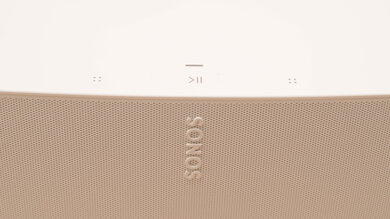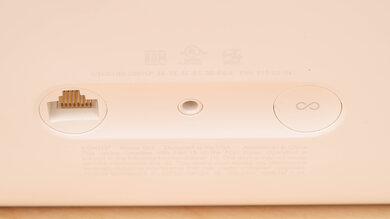The Sonos Five is a sleek wired speaker that's designed for home use. You can connect it to your phone and other mobile devices over Wi-Fi or Apple AirPlay, and if you have a third-party voice assistant device on hand, you can pair it to control the speaker with your voice. Like other Sonos speakers, its built-in Trueplay room correction tool optimizes its output based on your room's unique acoustics.
Our Verdict
The Sonos Five is good for music. It's a stylish home speaker with access to Sonos's room correction feature called Trueplay, which optimizes audio reproduction based on your room's unique acoustics. With it on, the sound profile is a bit bright, so while voices and lead instruments are clearly reproduced, you get a little extra sparkle with higher-pitched sounds. If you want a different output, you can always customize its bass and treble as well.
- Room correction tool.
- Bass and treble adjustments.
- A lot of compression at max volume.
The Sonos Five is a fair choice for videos and movies. You can stream audio from your phone over Wi-Fi and Apple AirPlay, and low latency ensures that you don't notice any issues with lip-synching. There's plenty of rumble in the bass to bring action-packed scenes to life, and dialogue is clearly reproduced. Plus, you can connect the speaker to other Sonos devices like a soundbar to create a home theater setup. However, at loud volumes, there's some compression and pumping artifacts in the mix.
- Bass and treble adjustments.
- Pairs to other Sonos speakers.
- Extended low-bass.
- A lot of compression at max volume.
The Sonos Five is a fair choice for podcasts. You can stream from your mobile devices over Wi-Fi. Voices and dialogue are clearly reproduced, and you get a little extra brightness in the treble to add sparkle to higher-pitched sounds. Also, it pairs with other Sonos speakers to spread audio throughout your home. While it gets loud on its own, there's some compression at max volume, so it's better suited for listening at an average volume level.
- Room correction tool.
- Pairs to other Sonos speakers.
- A lot of compression at max volume.
- Wired-only design.
The Sonos Five doesn't support native voice assistants. That said, the manufacturer advertises that you can control this speaker via Alexa or Google Assistant while it's connected to a third-party voice-enabled device over Wi-Fi.
This wired-only speaker isn't meant for outdoor use.
Changelog
- Updated Dec 21, 2023: Minor text edits for clarity. No changes in test results.
- Updated Nov 27, 2023: Added market comparison for the JBL Authentics 500 in the Voice Assistant box.
- Updated Apr 18, 2023: Added market comparison for the Sonos Era 300 in the Bluetooth box.
- Updated Apr 04, 2023: Added market comparison for the Marshall Woburn III in the Wired box.
Check Price
Differences Between Sizes And Variants
This speaker comes in two color variants: 'Black' and 'White'. We tested the 'White' variant, and you can see its label here. We expect the 'Black' color variant to perform similarly to our test unit.
If you come across another variant, please let us know in the forums, and we'll update our review.
Popular Speaker Comparisons
The Sonos 5 is a wired home speaker from 2020. It has a sleek and stylish design, and it's easy to integrate into your existing Sonos ecosystem. That said, this speaker doesn't come with as many features as newer Sonos home speakers like the Sonos Era 300. It lacks Bluetooth support, for example, and you can only access the voice assistants through a third-party device.
See also our recommendations for the best home speakers, the best smart speakers, and the best portable Bluetooth speakers.
The Sonos Era 300 is a newer release from the manufacturer, and it's more versatile than the Sonos Five. Notably, it offers Bluetooth connectivity as well as built-in voice assistant support, whereas the Five only supports voice assistants through third-party devices. The Era 300 has a better dynamics performance. Also, it supports Dolby Atmos for compatible music and videos streamed through a paired soundbar, unlike the Five. The slightly larger Five can reproduce a more extended low bass.
The JBL Authentics 500 is a more feature-packed speaker than the Sonos Five. Unlike the Sonos, the JBL has built-in voice assistant support, so you don't need to connect a third-party device. It gets louder and supports Bluetooth, too. However, it can't bring as much low-bass as the Sonos.
The Denon Home 350 is a slightly better speaker than the Sonos Five overall, though they perform similarly. The Denon can get louder with fewer compression artifacts, and it supports Bluetooth, although it has high iOS and Android latency. It also offers outstanding voice assistant support with Alexa built-in. However, the Sonos has a slightly better-balanced sound profile and it has a more immersive soundstage.
The Sonos Move and the Sonos Five have different strengths. The Move is better suited for outdoor use as it's battery-powered and has an IP56 rating for dust and water resistance. It also has outstanding voice assistant capabilities, and you can wirelessly stream audio to the device using Bluetooth. However, the Five is better suited for music as it can produce more low-bass, and it can be used in stereo or mono mode, depending on how it's placed.
Test Results

The speaker needs to remain connected to a power source to work, so you can't bring it with you outdoors like with the Sonos Move. Still, it's not very big, so you can move it from room to room with ease.
The speaker feels sturdy overall, and it's made of good-quality materials. There's even a graphite grille in front to protect its drivers inside. While it doesn't have an IP rating for dust and water resistance, the manufacturer says it's humidity resistant, meaning you can place it in high-humidity rooms like a bathroom with a running shower.
On top of the speaker, you find a set of touch-sensitive controls. You can tap two four-dotted buttons to adjust the volume or swipe to skip tracks. There's also a button between both dotted buttons that you can press and hold to play/pause audio or add the music playing in another room. It also has a physical join button, which allows you to reset the speaker or connect it to your wider Sonos system.
Like other Sonos speakers, there's a room correction feature available in its S2 app with iOS devices. It optimizes the speaker's audio reproduction based on your room's unique acoustics—Sonos calls it Trueplay. With it on, the speaker's frequency response is a bit bright overall. Voices and lead instruments are clear and present in the mix, but the extra emphasis in the treble adds more sparkle to higher-pitched instruments. There's plenty of rumble in the bass, making it suitable for other genres like EDM and hip-hop.
This speaker has a good soundstage performance. You can place it horizontally when you want to listen to stereo content and vertically for mono. Its directivity is decent, too, though you don't quite get consistent sound from all angles like with a 360-degree speaker.
This speaker gets loud enough to fill larger and more open rooms with sound. There's a bit of compression as you push it to max volume though, especially in the bass range.
While the Sonos 5 doesn't have any built-in voice assistants, the manufacturer states that you can control the speaker via Google Assistant or Alexa when connected to a third-party voice-enabled device over Wi-Fi. The JBL Authentics 500 is a good alternative if you prefer something with built-in support.
The Sonos S2 app is fantastic. While there's no graphic EQ, there are bass and treble adjustments to tweak the speaker's sound to your liking. You can also use the app to pair two Sonos speakers together to create a stereo pair or connect multiple speakers in separate rooms to play audio throughout your home wirelessly. There's also a Trueplay room correction feature that automatically tunes the speaker according to the unique acoustics of the room it's placed in. Unfortunately, this feature is only available with iOS devices.
Aside from its power port, this speaker features an AUX port you can use to wire older devices to it, and there's an Ethernet port to connect it to your home network. The Marshall Woburn III is a good alternative if you want a home speaker with HDMI ARC connectivity.
There's no Bluetooth support, unlike with newer Sonos speakers such as the Sonos Era 300.
You can wirelessly stream audio to the speaker over Wi-Fi or Apple AirPlay. Latency is low, too, so you don't notice a delay between the audio you hear and the visuals on screen.







